The speed of change in technologies means IT departments are undergoing major transformations every 18 months. While the technology curve bends exponentially, humansŌĆÖ ability to adapt to change is more linear and requires an equally adaptable leadership style. Use this research to help you divide your responsibility as IT leader across priority leadership areas to accelerate value creation and embrace a human-centric approach.
The most critical success factor for the future of IT is you, the IT leader, because leadership isnŌĆÖt just a job ŌĆō itŌĆÖs how you show up. Leadership in IT is fundamentally different than in other departments, due to shifting core responsibilities and greatly compressed timelines. These shifts demand a new form of leadership, and IT leaders must embrace an adaptive, multifaceted leadership style that integrates technology and people as a single, holistic system to set up their organizations for success.
1. Take charge in every area of leadership
IT leaders are expected to bridge technology and human-centered principles, moving beyond a singular focus on empathy or technical expertise toward a holistic approach. To succeed in the modern era of integration, leaders must drive adaptability at four levels ŌĆō enterprise leadership, strategic leadership, IT team leadership, and personal leadership.
2. 91ųŲŲ¼│¦ relationships with people, not technology
Shifting your role from problem-solver to organizational leader requires strong relationship building. Understanding the needs of key organizational players, communicating with them effectively, training staff, and executing on requests are the four most significant priorities to deliver value. Balance these equally to find the sweet spot between technology, business, and leadership that we call the ŌĆ£nexus of awesomeness.ŌĆØ
3. Conquer decision fatigue with flexibility
Leaders are expected to make ten times as many decisions daily as they were three years ago. Ad hoc processes and highly structured or authoritarian frameworks mean that leaders spend more time answering questions than they do leading. Center your organizational purpose in decision-making processes to empower leaders at many levels to make decisions like executives, giving you more time to and energy to focus on the bigger picture.
Use our insightful capstone to modernize your leadership mindset and stay in step with rapid technological development.
Use this research framework to redefine IT leadership from centralized and controlled to distributed and decisive. Our guide takes you through the most integral changes to ways of working as an IT leader, providing actionable steps and supporting Info-Tech resources to drive your journey forward.
- Embrace exponential technologies and maintain a human-centric approach to accelerate value creation.
- Drive adaptability across enterprise leadership, strategic leadership, IT team leadership, and personal leadership.
- Identify and execute on the right opportunities for your organization and intentionally pivot to ensure value.
Adaptive IT Leadership
Lead at the pace of exponential change.
Analyst Perspective
Leading is fundamentally different in IT. You need to lead in real time.
The most critical success factor for the future of IT is you, the IT leader, regardless of your role in the organization. The world around us has changed. The technology curve has bent exponentially, and there is no return.
Amid this change, something remarkable stands out: leadership has not evolved at the same pace. Despite the thousands of best-selling books on leadership, we still see a surprising lack of exceptional leaders. In today's world, what separates successful leaders from those who struggle? How does leadership need to evolve to keep up with the pace of change? One of the clearest findings is that leading in IT is fundamentally different from leading in other parts of an organization. If you work in IT, it's not unlikely that you've been through a transformation maybe even two, three, or more.
IT is unique in that the core responsibilities shift every 18 months or less. IT experiences transformations that require new technology skills and expectations on a compressed timeline. No other department faces this kind of rapid evolution. While other departments and leaders do experience change, none experience the same speed and intensity of change as those in IT. Transformation cycles in other areas marketing or finance, for example span years. In IT, they're measured in months.
How do you lead an organization that changes every 18 months?

Carlene McCubbin
Associate Vice President 91ųŲŲ¼│¦ Development, CIO
91ųŲŲ¼│¦
Executive Summary
| Your Challenge | Common Obstacles | Info-Tech's Approach |
|
Leading in IT is fundamentally different from leading in any other part of the organization.
This means that, in IT, you need to adapt to changing technology skills and expectations in real time. |
The pace of transformation does not show signs of slowing down. However, only 5% of IT organizations are currently meeting the expectations of other C-suite executives in their organization (Info-Tech CxO Alignment Diagnostic, 2020-2024; N=1,161). The top three pain points are:
At the end of the day, none of these are technology challenges. They all come down to people. |
Adaptive IT leadership helps set out the role of IT as an organizational leader and accelerates value creation by embracing exponential technologies and maintaining a human-centric approach. To do this, drive adaptability in four ways:
|
Info-Tech Insight
The critical success factor for exponential IT is you, regardless of your role in the organization. Leadership isn't a job it's how you show up. The world around us is constantly changing. The technology curve has bent exponentially and there is no return. This has left people feeling fearful, and when we're fearful, we regress. Leaders need to show up for each member of the team to help them think differently. Before leaders can do that, however, they need to start with themselves.
CIOs and CxOs agree that the future of transformation is IT-led
The pace of transformation shows no signs of slowing down.
According to Info-Tech's CxO Alignment Diagnostic, more than 50% of CxOs agree that IT's role is to expand (business partner) or transform (innovator) the organization. The catch? Only 5% of IT organizations are currently meeting this expectation.
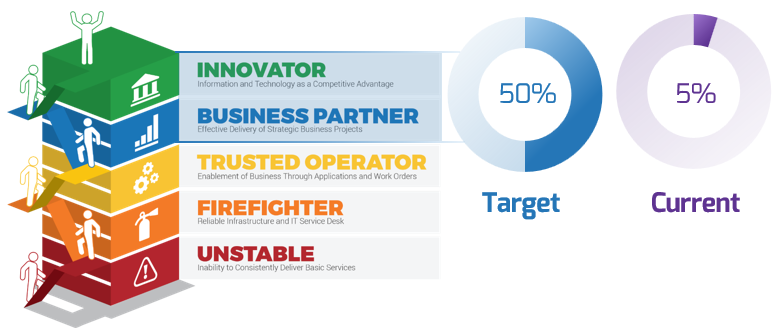
Source: Info-Tech CxO Alignment Diagnostic, 2020-2024; N= 1,161. The study included CxOs and CIOs from 384 unique organizations since Jan. 1, 2020.
CxOs and CIOs are aligned on the top three pain points:
- Staff sufficiency, skills, and engagement issues
- Business frustration with IT failure to deliver value
- IT limits affecting business agility
Notice that none of these are technology challenges. They all come down to people.
In IT, a lot changes in a little time
As organizations strive to succeed in the next phase of technology-driven transformation, CIOs will have an opportunity to demonstrate their organizational leadership. To do so, they will have to start delivering organizational capabilities, instead of services, while owning organizational targets. If IT leaders cannot lead the upcoming transformation, then the organization will move forward without them. For more information on opportunities in exponential technologies, see Info-Tech's Develop an Exponential IT Roadmap blueprint:
Develop an Exponential IT Roadmap
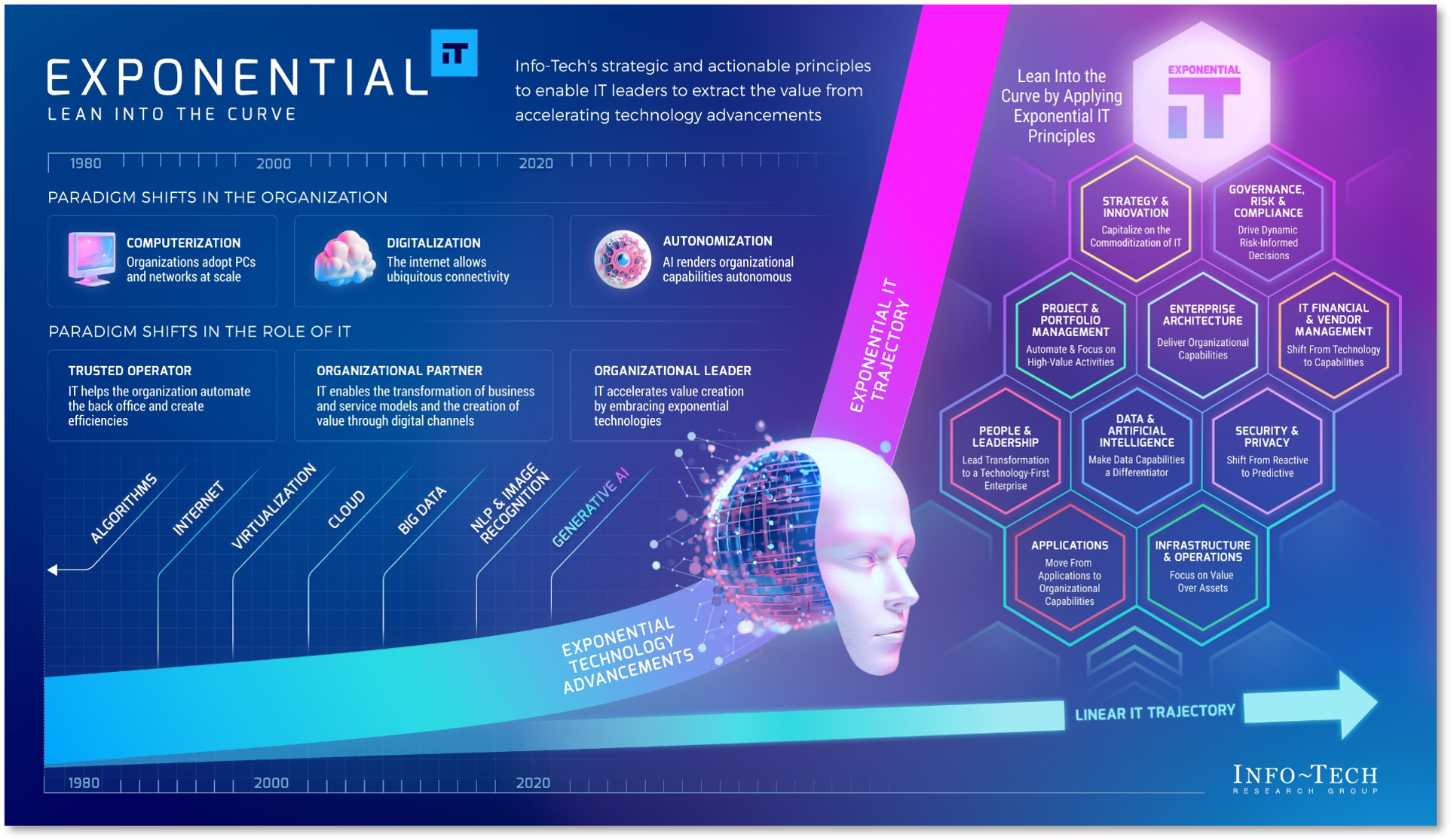
IT leaders are tasked to keep up with a world that won't wait
While the technology curve has bent exponentially, the human ability to adapt is better represented by a linear trajectory. It is this challenge of human adaptability that leaders need to address. Consider the images below: 30 linear steps representing human adaptability and 30 exponential steps representing exponential IT. By the time you walk to the corner store, technology change has looped Earth 26 times. How will you keep up to a world that won't wait?
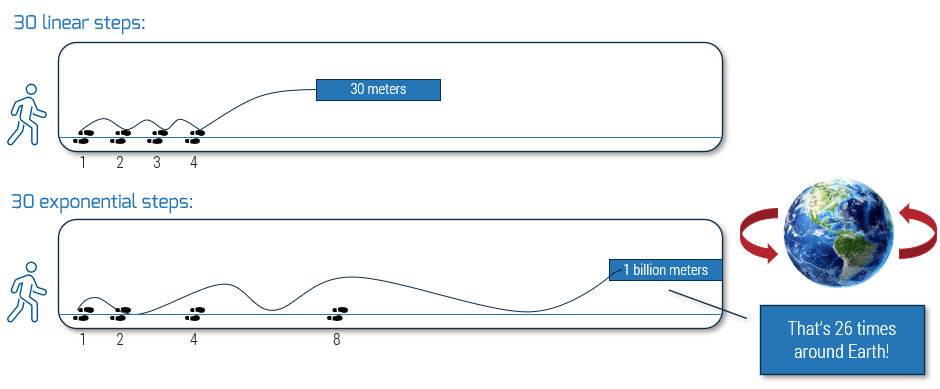
Source: Singularity Hub, 2016
Take a step back to see how IT has evolved
| Paradigm Shifts in the Organization | ||
| Computerization | Digitalization | Autonomization |
| Organizations adopt PCs and networks at scale. | The internet allows ubiquitous connectivity. | AI renders organizational capabilities autonomous. |
| Paradigm Shifts in the Role of IT | ||
| Trusted Operator | Organizational Partner | Organizational Leader |
| IT helps the organization automate the back office and create efficiencies. | IT enables the transformation of business and service models and the creation of value through digital channels. | IT accelerates value creation by embracing exponential technologies. |
| 1980 | 2000 | 2020 |
And how leadership has evolved in IT
| Paradigm Shifts in IT Leadership | ||||
| Expertise | Empathy | Integration | ||
| Technical knowledge and specialization were emphasized. Leaders were valued for their deep understanding of the technology domain. | Emotional intelligence, listening, and customer experience were at the forefront. There was an increasing focus on employee engagement, motivation, and wellness to carry us through the pandemic. | Leaders bridge technology and human-centered principles, moving beyond focusing on expertise or empathy to adopting a holistic approach. | ||
| Leadership Theory | ||||
|
Behavioral |
Contingency |
Transactional |
Transformational |
Adaptive |
| 1980 | 2000 | 2020 | ||
The role of IT as an organizational leader
Accelerate value creation by embracing exponential technologies.
The era of integration necessitates a change in the role of the IT leader as an organizational leader. IT leaders must bridge technology and human-centered principles. You need to drive adaptability at four levels:
- Enterprise Leadership
- Strategic Leadership
- IT Team Leadership
- Personal Leadership
We call this Adaptive IT Leadership.
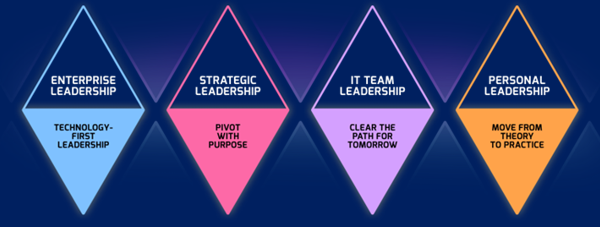
Info-Tech Insight
Technology is disrupting social systems. For much of our lives, technology has been a tool. Today, it's embedded in our social systems. IT leaders need to see technology this way they need to see that our social system is part of our world of work.
Adaptive IT Leadership
A set of core practices that enables IT leaders to drive sustainable change in the organization.
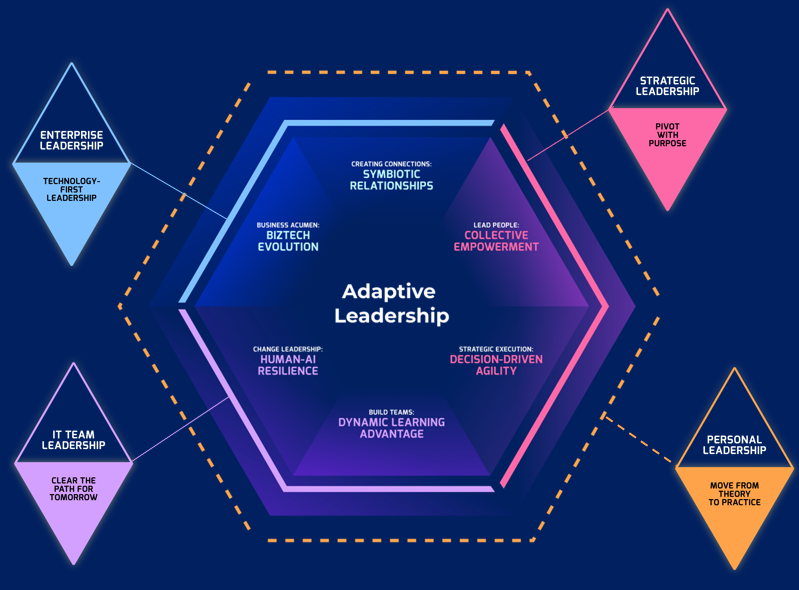
The Info-Tech Difference
- Use Info-Tech's Adaptive IT Leadership process to drive sustainable change. Each core practice is designed to help you navigate a rapidly changing IT landscape and make real-time changes to drive success.
- Propel yourself with a few adaptations to the leadership skills that got you to where you are.
- To do this, drive adaptability in four ways:
- Enterprise Leadership Identify and execute on the right opportunities for the organization.
- Strategic Leadership Create an environment where you intentionally pivot to ensure value of investments.
- IT Team Leadership Do more by creating space for success.
- Personal Leadership Make light-touch, high-impact observable changes in how you lead.
Insight Summary
Lead at the pace of exponential change.
The critical success factor for exponential IT is you, regardless of your role in the organization. Leadership isn't a job it's how you show up. The world around us is constantly changing. The technology curve has bent exponentially and there is no return. This has left people feeling fearful, and when we're fearful, we regress. Leaders need to show up for each member of the team to help each member think differently. Before leaders can do that, however, they need to start with themselves.
Lead with technology first.
Lead with technology first, not with technology for technology's sake. Identify and execute the right opportunities for the organization.
Pivot with purpose.
Most organizations are trapped by a three-year planning cycle that does not allow them to pivot in real time. To drive adaptability, you have to be able to use flexible decision-making and drive collective empowerment.
Clear the path to solve tomorrow's problems.
Adopt a transdisciplinary mindset. Focus on a mindset shift in which you're always thinking about how your skills can change and how you can collaborate with AI and others to execute in new ways.
Move from theory to practice.
Leading in IT is fundamentally different. It's different from leading in any other part of the organization, it's different than it was 18 months ago, and it will be different again in another 18 months. Your organization will evolve and so can you.

 Drive Adoption and Sustain Transformational Change
Drive Adoption and Sustain Transformational Change
 91ųŲŲ¼│¦ an Annual IT Talent Strategy
91ųŲŲ¼│¦ an Annual IT Talent Strategy
 Lead Staff through Change
Lead Staff through Change
 91ųŲŲ¼│¦ an IT Succession Plan
91ųŲŲ¼│¦ an IT Succession Plan
 Mitigate Key IT Employee Knowledge Loss
Mitigate Key IT Employee Knowledge Loss
 2020 IT Talent Trend Report
2020 IT Talent Trend Report
 Pandemic Preparation ŌĆō The People Playbook
Pandemic Preparation ŌĆō The People Playbook
 The Complete Manual for Layoffs
The Complete Manual for Layoffs
 Streamline Your Workforce During a Pandemic
Streamline Your Workforce During a Pandemic
 2021 IT Talent Trend Report
2021 IT Talent Trend Report
 IT Diversity & Inclusion Tactics
IT Diversity & Inclusion Tactics
 Design and Sustain a Purposeful IT Culture
Design and Sustain a Purposeful IT Culture
 The Accessibility Business Case for IT
The Accessibility Business Case for IT
 Communicate Any IT Initiative
Communicate Any IT Initiative
 Effective IT Communications
Effective IT Communications
 Initiate Digital Accessibility for IT
Initiate Digital Accessibility for IT
 Improve IT Team Effectiveness
Improve IT Team Effectiveness
 91ųŲŲ¼│¦ a Regular CEO IT Update Package
91ųŲŲ¼│¦ a Regular CEO IT Update Package
 CIO Time Study
CIO Time Study
 IT Talent Trends 2024
IT Talent Trends 2024
 Crack the Code to Successful Transformation Management
Crack the Code to Successful Transformation Management
 Chart Your Path: From Enterprise Architect to the Next CIO
Chart Your Path: From Enterprise Architect to the Next CIO
 Reputation Equals Revenue: Why Reputation Matters to IT as a Professional Service
Reputation Equals Revenue: Why Reputation Matters to IT as a Professional Service
 Strengthening the CIO Brand: From Perception to Reality
Strengthening the CIO Brand: From Perception to Reality
 Adaptive IT Leadership
Adaptive IT Leadership
 IT Talent Trends 2025
IT Talent Trends 2025
 Adaptive IT Leadership Keynote
Adaptive IT Leadership Keynote
 Leading People Change in the Face of Disruptive Technology
Leading People Change in the Face of Disruptive Technology
 The Race to Develop Talent
The Race to Develop Talent